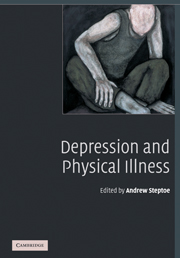Book contents
- Frontmatter
- Contents
- List of contributors
- Preface
- Part 1 Introduction to depression and its determinants
- Part 2 Depression and specific health problems
- 3 Depression and the development of coronary heart disease
- 4 Depression and prognosis in cardiac patients
- 5 The management of depression in patients with coronary heart disease
- 6 Depression and physical disability
- 7 Chronic pain and depression: twin burdens of adaptation
- 8 The interrelationship of depression and diabetes
- 9 Depression and chronic fatigue
- 10 Cancer and depression
- 11 Depression and obesity
- Part 3 Biological and behavioural processes
- Part 4 Conclusions
- Index
- References
5 - The management of depression in patients with coronary heart disease
from Part 2 - Depression and specific health problems
Published online by Cambridge University Press: 17 September 2009
- Frontmatter
- Contents
- List of contributors
- Preface
- Part 1 Introduction to depression and its determinants
- Part 2 Depression and specific health problems
- 3 Depression and the development of coronary heart disease
- 4 Depression and prognosis in cardiac patients
- 5 The management of depression in patients with coronary heart disease
- 6 Depression and physical disability
- 7 Chronic pain and depression: twin burdens of adaptation
- 8 The interrelationship of depression and diabetes
- 9 Depression and chronic fatigue
- 10 Cancer and depression
- 11 Depression and obesity
- Part 3 Biological and behavioural processes
- Part 4 Conclusions
- Index
- References
Summary
Introduction
Patients who survive an acute myocardial infarction (MI) often face a difficult period of psychological and social adjustment. During the weeks and months following an MI, survivors are confronted with the possibility of being physically incapacitated, of having another heart attack and of dying. Their usual roles and daily routines may be disrupted, their self-esteem may be injured, and some of their hopes and plans may be jeopardised. Even patients with stable coronary heart disease (CHD) who have never had an MI or other major cardiac event must live with the possibility that they might eventually have a heart attack, and many of them have to cope with angina pectoris, fatigue and other debilitating symptoms.
Given the stressors with which patients with CHD are confronted, it is not surprising that depression and anxiety are very common in these individuals. As many as 65% of post-MI patients are at least mildly anxious or depressed [1–3]. Although some patients return to their premorbid mood state within a few days or weeks after their MI, many have, or will develop, a more serious or persistent form of clinical depression.
Depressive disorders
The Diagnostic and Statistical Manual of Mental Disorders, 4th edn (DSM-IV-TR) of the American Psychiatric Association [4] defines the most widely used criteria for diagnosing psychiatric disorders. As described in DSM-IV-TR, major depression is a serious psychiatric disorder that tends to follow a chronic or recurrent course.
Keywords
- Type
- Chapter
- Information
- Depression and Physical Illness , pp. 109 - 124Publisher: Cambridge University PressPrint publication year: 2006
References
- 2
- Cited by



